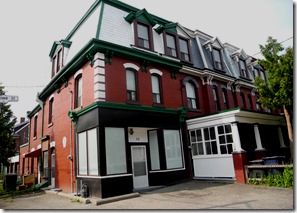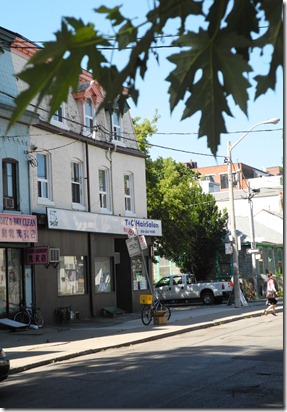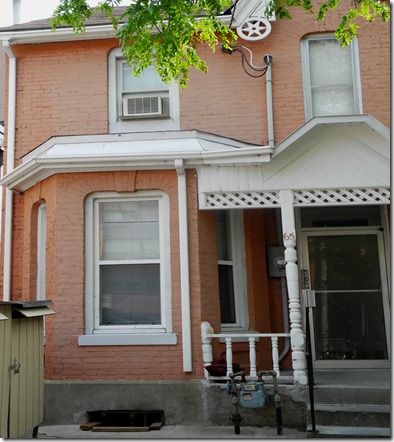One of Toronto’s timeless residential streets near Huron Street amid the downtown core
During the heat wave in August of 2012, I visited Huron Street, and discovered that it was possible to imagine what it would have been like to be a child playing on the street on a hot summer day in the 1890s. The rows of houses that remain are the same ones that graced the avenue in the last decade of the nineteenth century. The laneways where children played their rough and tumble games of “British Bulldog” still exist, as well as the mature deciduous trees that shaded residents from the heat of the summer sun. I found it easy to envision children waiting for the iceman to deliver a block of ice to a home. When his cart was unattended, the youngsters could then descend on the cart, lift the canvas cover, and purloin small shards of ice. Finding a cool spot to sit, they would suck on the refreshing treat. However, if a few coins came their way, they visited one of the corner grocer stores to purchase an ice cream cone.
On Huron Street, corner stores from the last century remain in existence today, although they no longer sell groceries. Sadly, their windows are covered over. They no longer have children excitedly rushing inside their doors to purchase penny candy. Below is a 1890s map of Huron Street, depicting the section of Huron Street between Phoebe St. on the south, and Grange Avenue on the north. Huron St. is one block east of Spadina Avenue. The houses that are shown on this map remain in existence today.
The above map in from the Goad’s Atlas of 1895-8.
There was a time when every neighbourhood possessed corner stores similar to the one in the above picture. They supplied the daily needs of the families that lived within walking distance. Most of these stores disappeared when shopping malls and plazas appeared on the scene in the 1950s. The corner stores on Huron Street have also closed, but the buildings that contained them remain, reminders of a by-gone era.
All the buildings in the pictures below are located on corners that intersect with Huron Street. In the nineteenth century they were busy enterprises. Although the shops on Spadina were only a few blocks to the west, many preferred the local corner stores where the merchants knew their customers’ names and was familiar with their preferences in goods. The names given below for the various shopkeepers are for the year 1897.
53 Sullivan St, – R. McFarland, grocer 51 Sullivan St. – Thomas Pendergas- grocer
54 Grange Ave., Wm. H. Moore, grocer 52 Grange Ave., John R. Outhet, butcher
49 Grange Ave., Wm. M. Rae, grocer
Below are photos of a few of the homes that graced Huron Street in the 1890s. Today, their charm has not diminished.
In the 1890s, this home at 31 Huron Street was the residence of Henry Donley, a manager at W.J. Donley Ltd. Its first-floor bay window flooded the interior of the home with light in an era without electricity.
This residence at 65 Huron St. was the home of W. Smith in 1897.
In 1897, this house at 36 Huron Street was the home of William H. Rumball, a tailor by trade. The house is located on the southwest corner of Huron St. and Grange Avenue.
The impressive Richardson Romanesque-style home at 37 Huron St.
In 1897, the large house pictured above was the home of Isaac Rittenberg, a jeweller by trade. In addition, living in the house were two retired gentlemen – William Hicks and William Lannen. The laneway beside the home at #37 Huron Street was where children played games. Today, it is names Orphanage Mews.
I have spent much of my adult life researching Toronto. Despite the traffic jams and daily congestion, I find Toronto an exciting and vibrant city in which to live. I enjoy exploring its past through my writing. One of the books, “The Villages Within”, was nominated for the Toronto Heritage Awards. If interested in novels with a Toronto setting, descriptions of the books are available by following the link: https://tayloronhistory.com/2012/03/22/toronto-author-publishes-seventh-novel/
They can be purchased in soft cover or electronic editions. All books are available at Chapters/Indigo and on Amazon.com. The electronic editions are less than $4 on Kobo and Kindle. Follow the links:
There Never Was a Better Time: http://bookstore.iuniverse.com/Products/SKU-000056586/THERE-NEVER-WAS-A-BETTER-TIME.aspx
Arse Over Teakettle: http://bookstore.iuniverse.com/Products/SKU-000132634/Arse-Over-Teakettle.aspx
The Reluctant Virgin; http://bookstore.iuniverse.com/Products/SKU-000188306/The-Reluctant-Virgin.aspx
The Villages Within: http://bookstore.iuniverse.com/Products/SKU-000175211/The-Villages-Within.aspx
Author’s Home Page: https://tayloronhistory.com/
Authors can be contacted at: [email protected]













Looking for information about 485 Huron Street in 1965
Dear Friend,
I grew up in Toronto in the 40s and early 50s, and lived on classic Avenue between Huron Street and St. George. This was an extension of the section of classic Avenue that existed between Spadina and Huron Street. It no longer exists, as it was torn down when the Sydney Smith hall at the U of T was being planned. I have no pictures of that time of my use, and would love to be direct to any photographs that may exist, on the Internet, or in publications that you may know of. That part of the city was an important neighborhood to me, as I Spent many years exploring and enjoying the streets and back alleys of that part of Toronto. With great appreciation, Ronald Sawchuk.
City of toronto archives will likely have something. There’s an online database and also the actual physical archive building on Spadina Rd north of Dupont.